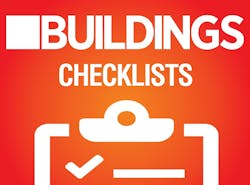Annual Fire Inspection Guide - Exclusive Checklist
Prepare for your next fire inspection.
Access and Premises
- Building address should be clearly visible from street.
- Exterior access should be clear.
- Fire department connection should be clearly visible and readily accessible.
- Lockbox should be accessible and have proper keys for complete building access.
- Fire hydrants should be visible and accessible.
Help BUILDINGS Shape 2019!
What BUILDINGS resources are most valuable to you? What would you like to see us provide?
Please take our short (under 2 minutes) survey - just 5 short questions.
Thank you!
Means of Egress
- All exit doors should be visible, accessible, and fully functional.
- All exit doors should readily open from the inside without the use of a key or special knowledge or effort.
- All required fire doors must be self-closing and latch in the closed position.
Read also: Ways Your Fire Safety System Could Be Failing You
Electrical
- Cover plates should be installed on all electrical receptacles.
- All circuits should be properly labeled on all electrical panels.
- There should be 30 inches of clear access in front of all electrical panels.
- Extension cords shouldn’t be used, except for temporary power.
- All extension cords should be heavy duty, in good condition, and used for only small appliances.
- All extension cords should be grounded.
- If multiple items need to be plugged in, power strips with built-in circuit breakers should be used, and should be plugged directly into a permanent receptacle.
Egress Lighting
- All means of egress should be properly illuminated when the building is occupied.
- All emergency lighting units should be operable and properly located to illuminate all portions of the means of egress (push test button to check).
- All exit signs should be properly illuminated, and battery back-up should operate (if required – push test button to check).
Fire Extinguishers
- Generally, fire extinguishers should be installed within 75 feet of all areas of the building.
- All extinguishers should be visible and readily accessible.
- All extinguishers should meet the minimum required rating, or should be installed for special hazards.
- All extinguishers should be installed at the proper height above the floor (generally, the top of the extinguishers should be no more than 5-feet above the floor).
- All extinguishers should’ve been inspected and tagged by an approved agency within the past 12 months.
Fire-Alarm System
- An annual fire-alarm system functional performance test should be completed, along with a record of completion (you should have a copy available for the fire inspector).
Fire-Sprinkler System
- Annual fire-sprinkler-system inspection, testing, and maintenance should be completed, along with a record of completion (you should have a copy available for the fire inspector).
- All storage should be located at least 18-inches below all fire sprinklers (in large warehouses, storage heights may be different).
Special Suppression Systems (Kitchen Wet Chemical, Clean Agent, Etc.)
- Annual or semi-annual special fire-suppression system inspection, testing, and maintenance should be completed, along with a record of completion provided (you should have a copy available for the fire inspector).
Heat-Producing Appliances and Devices
- Only UL-Listed portable electric heaters should be used, and only on a temporary basis.
- All electrical portable heaters should have a clear space on all sides of at least 36 inches.
- All gas-fired heat-producing appliances (furnaces, water heaters, etc.) should have a clear space from combustibles of at least 36 inches on all sides.
- All gas-fired heat-producing appliances should have vents properly installed and maintained.
- Proper clearance of combustibles should be maintained from all light fixtures.
Storage and Maintenance of Building Areas
- All trash and waste should be removed from the building daily (it’s not allowed to accumulate).
- All oily rags or similar materials should be stored in approved metal containers.
- All combustible materials should be stored in an orderly manner.
- No combustibles should be stored in any portion of the means of egress.
- All combustible decorations should be properly treated with fire retardants.
- All interior finishes should meet the code requirements for the type of occupancy.
- All combustible or flammable liquids should be properly stored in approved containers or cabinets.
- All compressed gas containers (tanks) should be secured to prevent them from falling over.
Smoke and Carbon-Monoxide Alarms
- All single- or multiple-station smoke alarms (detectors) should be operating properly (batteries should be replaced annually).
- All carbon-monoxide detectors should be operating properly.
Looking for more downloadable checklists?

